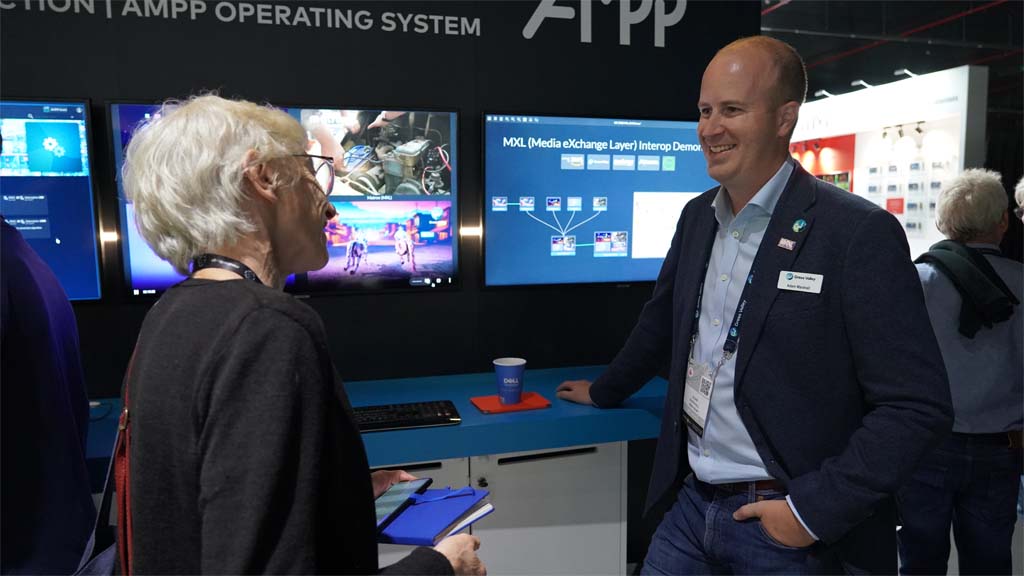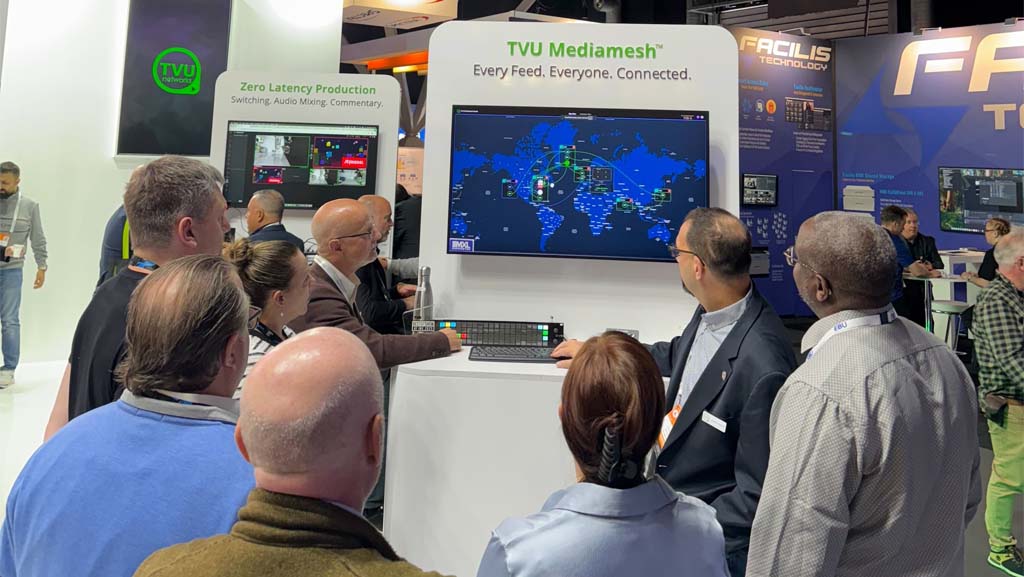Fast Tracks Open for Broadcasters Transitioning to Live IP Production
Advances in handling an increasing variety of protocols help drive new adoptions

TV broadcasters concerned about transitioning sports, news and other live production workflows to IP have every reason to throw those cautions to the stiffening winds of change.
Thanks to a swelling tide of innovations aimed at addressing the challenges, the transition isn’t nearly as difficult as it once was. New vendor platforms enabling flexible single-portal management of different protocols as the transition unfolds, better performance from cloud-based software once the transition is made and greater interoperability among competing solutions promise to put the migration to next-generation live production on a much faster track than has been the case so far.
Up to now, the dominant trend has centered on hybrid approaches that retain SDI amid the incremental introduction of ST 2110 in core A/V production workflows while leveraging ST 2110 and, with ever-greater frequency, the Network Device Interface (NDI) IP transmission protocol to transport IP streams into and out of those workflows.
As measured by Haivision in its latest annual survey of hundreds of broadcasters worldwide, 50% of respondents were using a hybrid video infrastructure combining SDI, IP, and cloud technologies as of late 2024, compared to 44% a year earlier, while 31% still solely relied on SDI and only 14% had moved to all-IP.
It’s Now Table Stakes
For many broadcasters trying to remain competitive in a fragmented multidevice market demanding new features and applications, the leap to IP has now become table stakes. “It scales better than any other technology, which is why we see most of our largest customers eager to make the transition,” said Alun Fryer, technical marketing lead for hyperconverged solutions at Ross Video.
A huge number of customers still think SDI works for them, but it’s not future-proof.”
Christian Scheck, Lawo
“NDI doesn’t need 2110 to work with SDI,” he notes, but it takes 2110 to do in IP what SDI does with “the flexibility to work with audio and video separately.” That means for users of NDI who want to get to an all-IP mode of production the question is, “How do I bring NDI into the 2110 world?”
Ross’ answer is the Ultrix platform, an appliance that integrates routing, signal processing and switching equipment to overcome the hassles of managing separate components. By abstracting SDI, ST 2110, and NDI along with newer IP transport frameworks like Dante AV and possibly Internet Protocol Media Experience (IPMX) if demand warrants, the format-agnostic Ultrix platform consolidates everything for management on a single user interface, Fryer said.
The professional video industry's #1 source for news, trends and product and tech information. Sign up below.
Matt Weiss, vice president of business development and manager partner for BeckTV, said the systems integrator is seeing more broadcasters make the shift to IP for live production, “but every project comes with its own set of hurdles.”
“Moving to SMPTE 2110 and cloud workflows requires not only new infrastructure but also a new way of thinking about system design and signal flow,” Weiss said. “The biggest challenge isn’t the hardware, but the complexity of integrating diverse platforms, evolving standards and unique client requirements. Success depends on having people who can bridge the gap between IT and broadcast, ensuring that the technology delivers the flexibility that broadcasters expect without compromising reliability.”
Adam Marshall, chief product officer at Grass Valley, said the continuing shift to IP makes total sense for broadcasters.
“Customers more generally are looking for the flexibility and agility that IP brings, which is absolutely tantamount to being successful from a technology spend perspective,” Marshall said.
That said, Grass Valley, like other leading vendors, is taking steps in product development to ensure that broadcasters “looking for simplicity to avoid the 2110 educational overhead” can benefit from advances underway in the SDI domain, Marshall adds. Notably, there’s a resurgence of interest in SDI spurred by the opportunity to upgrade from 3G-SDI channels supporting HD 1080-caliber production to 12G-SDI channels supporting UHD 4K production workflows.
Full Control and Flexibility
Grass Valley’s latest steps toward accommodating such diversity on the path to IP were on display at the 2025 IBC Show in Amsterdam last month. The company touted its GV Media Universe as a multivendor environment in which its virtualized Agile Media Processing Platform (AMPP) operates as a single control layer seamlessly integrating live production workflows across its own and other hardware and software solutions.
“The goal is to give customers full control and flexibility, so they can decide how, where, and when to deploy their infrastructure,” Marshall said. Toward that end, Grass Valley is now taking orders for its soon-to-be-released Agile Computing Engine (ACE) 3901 server card, a dense processing gateway that can bridge the latest advances like 12G-SDI channels at high volumes into the AMPP OS, whether they run on hardware or software.

Notably, as an accelerator to cloud-based IP migration, the ACE 3901 also brings Grass Valley’s innovative use of microservices into play with the AMPP OS. The company’s new AMPP GRID fabric orchestrates microservices running in a shared multivirtualized server environment to achieve processing performance matching its Field Programmable Gate Array (FPGA)-based appliances. Combining AMPP GRID with AMPP OS via the ACE 3901 platform “allows you to run over 300 native apps in live production,” Marshall said.
In another turn to open networking, TVU, long a leading force behind the connection of remote news and sports camera feeds over IP links to distributed production workflows, has responded to broadcasters’ migrations to cloud production by opening its MediaMesh-based remote production ecosystem to access by competitors.
TVU’s cloud-based software-as-a-service (SaaS) solution set allows operators anywhere to synchronously manage production from their web browsers with edits executed on resolution-reduced proxies instantly transferred to core high-res frames. “We’ve developed an entire live production suite in the cloud,” said Matt McEwen, vice president of product management at TVU. “If someone does something on a frame, the other operators will see that. We assemble everything in the background with the same time stamps.”
At IBC, the company debuted TVU MediaMesh as a shared memory space for live video with open APIs that make live signals instantly accessible to any authorized tool or production team anywhere.
At the same time, TVU made its SaaS solution components available as microservices, allowing “users to build unique solutions to accomplish one thing without using all the bells and whistles,” McEwen said.
Meanwhile, leading suppliers of the video cameras that feed live sports, news and other coverage into broadcast production workflows are vying to play a major role in driving the shift to IP. They’re providing operators the flexibility to mix camera outflows over SDI and IP transport protocols with the use of live production switchers supporting SDI and ST 2110 workflows in whatever end-to-end combinations work for them.
“We’re seeing a shift to IP-based workflows, especially in the high-end broadcast space,” Peyton Thomas, a product manager at Panasonic, said. “And 2110 has become a more viable option even in midmarket broadcast operations.”
We’re seeing a shift to IP-based workflows, especially in the high-end broadcast space. And 2110 has become a more viable option even in midmarket broadcast operations.”
Peyton Thomas, Panasonic
Panasonic’s 4K Studio and soon-to-be-released 4K Multipurpose Cameras enable the selection of multiple transport options, including ST 2110, NDI, SRT and dual 12G-SDI outputs, without the use of an external camera control unit (CCU). These can be fed into live production workflows by Panasonic’s KAIROS IT/IP software system running on core server mainframes that combine GPUs and CPUs to enable live A/V production processing with an unrestricted number of media effects utilizing SDI baseband or IP signals formatted to ST 2110, NDI or SRT.
“Our selling point for KAIROS is it’s an all-in-one kind of solution,” Thomas says. “It can be used by a single operator performing the entire production or with production split among multiple specialists.”
In the Mix
Sony Electronics, too, has put much innovative energy into simplifying the transition to live production through its Networked Live portfolio of cameras, switchers, media edge processors and other tools. It’s an ecosystem designed with a commitment to open interfaces that enable customers to mix other vendors’ products into operations as they see fit, according to Rob Thorne, Networked Live category head for the Live Production Solutions team at Sony Europe. There’s much mixing of SDI, 2110, NDI and SRT now, which is “something we never saw before,” he notes.
Sony’s latest generation of high-end HDC-5500/5500V cameras used to capture sports and other live events come with optional adapters enabling ST 2110 signal output, including JPEG XS capabilities, without requiring CCU support. The company’s NXL-ME80 high-compression edge encoders, in combination with its MSL-X1 switchers, enable live production operations that can feed output from remote SDI and IP sources over low-bandwidth connections into core ST 2110 production workflows, with final output conforming to the low-latency requirements of live sports distribution.
For some vendors like Lawo and Techex, rather than creating transitional platforms, the focus is on making sure broadcasters who are jumping all in to IP production have the best possible working environment. Until now, there haven’t been enough decision-makers ready to take a serious look at the options, says Christian Scheck, head of content marketing at Lawo.

“Unfortunately, a huge number of customers still think SDI works for them, but it’s not future-proof,” he sid. “If operations grow, as they invariably will, the capacity limitations of SDI routing will always be a problem.”
Lawo’s latest moves to make production over IP more attractive entail enhancements to its core HOME platform, which offers centralized on-site or remote discovery, authentication, security management and monitoring of all production-connected devices from a single user interface. The new HOME Apps include a new UI, a new production Multiviewer minimizing bandwidth and CPU usage and a HOME ecosystem extension that enables maximum infrastructure utilization in the creation of production facilities.
Techex is a longtime provider of services and products enabling Tier 1 sports broadcasters to bridge the gap between M&E production experts anchored in the SDI hardware space and cloud-native engineers who “understand how to build future-facing software but don’t understand broadcast,” according to Chief Product and Technology Officer Richard Bailey. Long serving in the background with a growing list of Tier-1 sports broadcasters, Techex is raising its profile as the need to overcome the pitfalls of taking shortcuts in the cloud grows more urgent.
Issues often have to do with utilization of generic open-source cloud platforms that are “incredibly powerful but aren’t designed for the precise needs of Tier-1 sports producers,” Bailey said. He cites the tx darwin microservices-based platform as key to addressing these problems with solution modules enabling secure and flexible live media processing, transport and monitoring with seamless transport stream switching, advanced remultiplexing and high-performance channel delays supporting failover between cloud infrastructures.
The shift to live cloud production is becoming a “very common trend in the market,” Bailey said. “The reason we’re playing an increasing role is the increasing difficulties that come with making that transition.”
Fred Dawson, principal of the consulting firm Dawson Communications, has headed ventures tracking the technologies and trends shaping the evolution of electronic media and communications for over three decades. Prior to moving to full-time pursuit of his consulting business, Dawson served as CEO and editor of ScreenPlays Magazine, the trade publication he founded and ran from 2005 until it ceased publishing in 2021. At various points in his career he also served as vice president of editorial at Virgo Publishing, editorial director at Cahners, editor of Cablevision Magazine, and publisher of premium executive newsletters, including the Cable-Telco Report, the DBS Report, and Broadband Commerce & Technology.

